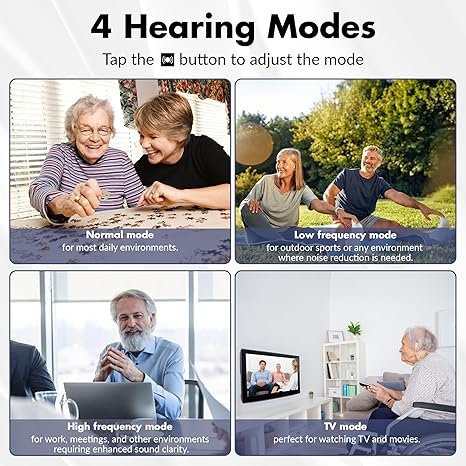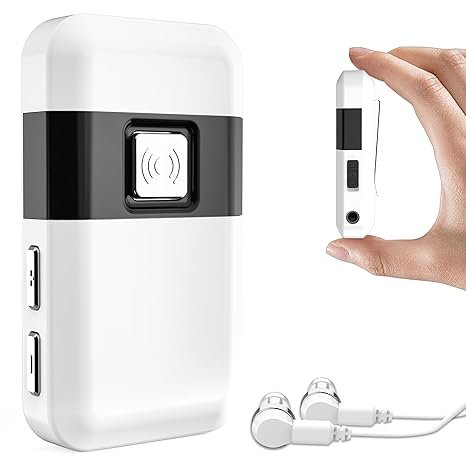Introduction to Hearing Aids
Hearing aids are sophisticated electronic devices designed to amplify sound for individuals experiencing hearing loss. They serve as a critical tool for improving communication, especially for seniors who may face age-related auditory challenges. By amplifying sounds, hearing aids facilitate interactions in various environments, enabling users to participate fully in conversations, social events, and daily activities.
The fundamental function of hearing aids is to capture sound waves, convert them into electrical signals, and then amplify these signals for the user. Most modern hearing aids are equipped with features such as directional microphones, which enhance sounds coming from specific directions while reducing background noise. This is especially beneficial in crowded or noisy settings, allowing seniors to focus on conversations without unpleasant distractions.
There are several types of hearing aids available on the market today, including behind-the-ear (BTE), in-the-ear (ITE), and completely-in-canal (CIC) models. Each design has distinct benefits and caters to different types of hearing loss. For instance, BTE hearing aids are often preferred for their power and ease of handling, while CIC models offer a discreet option for users who prioritize aesthetics.
As technology advances, rechargeable hearing aids have emerged as a vital innovation in the field. Unlike traditional models that rely on disposable batteries, rechargeable hearing aids provide convenience and sustainability. Many of these devices come equipped with cutting-edge features like noise cancelling, which significantly reduces unwanted background noise, and adjustable volume levels, allowing users to customize their auditory experience according to their preferences. This integration of advanced functionalities illustrates the ongoing commitment to improving the quality of life for seniors with hearing loss.

Benefits of Rechargeable Hearing Aids
Rechargeable hearing aids have gained significant traction in recent years, particularly among seniors. One of the main advantages of rechargeable models over traditional battery-operated ones is the convenience they provide. Seniors often face challenges related to dexterity and vision, making the task of changing tiny batteries cumbersome. Rechargeable hearing aids eliminate this difficulty; users can simply place their devices in a charging dock each night, ensuring that they are fully powered for the day ahead without the added hassle of battery replacements.
Cost-effectiveness also plays a pivotal role in the growing popularity of rechargeable hearing aids. Although the initial investment may be slightly higher, the long-term financial benefits outweigh the upfront costs. Traditional batteries require regular purchasing and replacement, which can accumulate over time. In contrast, rechargeable hearing aids reduce ongoing expenses, as users can significantly lower or completely eliminate the need to buy disposable batteries. This is particularly beneficial for seniors on fixed incomes, allowing them to allocate their funds more efficiently.
Moreover, rechargeable hearing aids often come equipped with advanced technologies, including noise-canceling features and multiple volume levels that cater to various listening environments. These enhancements contribute to a better listening experience, making it easier for seniors to engage in conversations and enjoy social interactions. The ability to adjust volume settings seamlessly further simplifies the process, allowing users to customize their auditory experience to meet their needs, which can be particularly advantageous in varying settings like restaurants or family gatherings.
In conclusion, the benefits of rechargeable hearing aids for seniors encompass convenience, cost savings, and ease of use. By embracing this technology, seniors can enjoy improved hearing health and a more fulfilling social life, highlighting the importance of choosing the right hearing assistance options in today’s world.
Understanding Noise Cancelling Technology
Noise cancelling technology has become an integral feature in modern hearing aids, particularly for seniors who often struggle with background noise. This technology works by using microphones to detect external sounds and generating sound waves that are the inverse of those noises, effectively reducing their impact. As a result, users can experience a clearer audio environment, allowing for a more enjoyable listening experience. For elderly individuals, this is particularly beneficial when participating in conversations amidst potentially distracting settings, such as crowded restaurants or family gatherings.
One of the key advantages of noise cancelling features in rechargeable hearing aids is that they enable seniors to focus more intently on speech sounds without the hindrance of background noise. This capability is especially vital for individuals who may have age-related hearing loss, as they are more susceptible to struggling with distinguishing conversations in noisy environments. By minimizing unwanted sounds, noise cancelling technology allows users to improve their understanding of speech, thereby enhancing their overall communication experience.
In conclusion, noise cancelling technology significantly enhances rechargeable hearing aids by reducing background noise and improving speech clarity. As such, understanding its functionality and limitations can assist seniors in making informed choices when selecting hearing aids that best suit their needs.

Adjustable Volume Levels: An Essential Feature
Adjustable volume levels serve as a critical component in the design of modern rechargeable hearing aids, particularly for seniors experiencing varying degrees of hearing loss. With multiple volume settings, these devices provide the user with the flexibility to tailor their hearing experience according to specific listening environments. This customization is paramount as seniors often find themselves in a variety of soundscapes, from quiet rooms to bustling social gatherings. The ability to modify the volume enhances their overall experience and ensures they do not miss essential conversations or sounds.
One of the primary benefits of having multiple volume levels is the capacity to optimize sound clarity. For instance, low volume settings may be preferable in serene conditions like watching television or listening to soft music, allowing users to enjoy auditory stimuli without overwhelming sound. Conversely, during social interactions or noisy public environments, higher volume settings can be instrumental in filtering out background noise while amplifying relevant sounds. This is particularly significant for seniors, many of whom may require different levels of assistance throughout their day-to-day activities.
Moreover, customizable volume settings cater to individual needs in a way that one-size-fits-all solutions simply cannot. Hearing loss can greatly vary not only among different individuals but also for the same individual across different situations. By adjusting the volume to suit their immediate environment, users can achieve a more comfortable and engaging auditory experience. This personalization fosters greater independence in social situations, allowing seniors to participate more actively without straining to hear. Ultimately, incorporating this feature enhances the overall effectiveness of rechargeable hearing aids, making them a valuable aid in improving quality of life for seniors with hearing challenges.
Top Rechargeable Hearing Aids Reviewed
In the market for rechargeable hearing aids designed specifically for seniors, several products stand out due to their enhanced noise cancelling features and volume control capabilities. This section reviews some of the most popular models, examining their key features, performance, and user feedback.
The Phonak Audeo Paradise is frequently highlighted for its superior sound quality and seamless connectivity. This hearing aid offers advanced noise cancelling technology, allowing users to focus on conversations without background distractions. Featuring eight programmable volume levels, it caters to various listening environments. Customer reviews note its comfortable fit and long battery life, making it a preferred choice for many seniors. However, some users point out a learning curve involved in adjusting to its touch controls.
Another noteworthy option is the Oticon More. Known for its excellent ability to manage challenging sound environments, this device utilizes a unique deep learning engine to enhance the listening experience. With 8 different volume levels, users have the flexibility to customize their auditory experience. Feedback from users emphasizes its clarity and comfort, although some have mentioned that it is relatively expensive compared to other models in the market.
Lastly, the ReSound ONE deserves attention for its innovative design and multifaceted noise cancelling features. This hearing aid not only allows for individualized volume control but also offers direct streaming capabilities from smartphones. Users appreciate its robust performance, especially in noisy settings. However, some complaints about its bulkiness and occasional connectivity issues have been noted.
By evaluating these popular rechargeable hearing aids, seniors can make informed choices based on the function and features that prioritize their lifestyle and hearing needs.

User Experience and Feedback
The experiences of seniors who have used rechargeable hearing aids provide valuable insights into their functionality and effectiveness. Many users have reported significant improvements in their daily lives due to the enhanced noise cancellation technology incorporated into these devices. For instance, one user noted that the ability to filter out background noise enabled him to engage in conversations without straining to hear every word, thus improving his social interactions and overall quality of life.
Satisfaction with the volume levels offered by rechargeable hearing aids is another prominent aspect of user feedback. With the availability of up to eight customizable volume settings, many seniors appreciate how these settings cater to their individual hearing needs in various environments. A retired school teacher expressed her delight when she could adjust the volume depending on whether she was in a quiet room or a bustling restaurant. This adaptability is crucial for seniors who may find themselves in diverse scenarios throughout the day.
Comfort is a vital factor, and numerous testimonials emphasize how lightweight and ergonomically designed rechargeable hearing aids have made a difference. One user described the peace of mind that comes from wearing a device that feels comfortable even after hours of use. With options available that provide a snug yet unobtrusive fit, seniors are more likely to wear their hearing aids consistently, which enhances their effectiveness over time.
Overall, user experiences with rechargeable hearing aids highlight a consensus of satisfaction regarding noise cancellation, volume versatility, and comfort. These real-world insights not only showcase the benefits of modern hearing aid technology but also underscore the importance of user-focused design in enhancing the auditory experiences of seniors.
Comparing Rechargeable Hearing Aids with Traditional Models
When evaluating hearing aids, it is essential to consider the differences between rechargeable and traditional models, as each comes with its own set of advantages and disadvantages. One of the most notable distinctions lies in functionality. Rechargeable hearing aids are designed to be conveniently charged overnight, eliminating the need for frequent battery replacements. This feature can significantly benefit seniors who may struggle with handling small batteries due to dexterity issues or cognitive challenges associated with aging. In contrast, traditional hearing aids rely on disposable batteries, requiring users to have a stockpile on hand and necessitating regular changes, which may not be user-friendly.
Cost is another critical factor to consider. Initially, rechargeable hearing aids may appear more expensive than traditional models; however, the long-term financial implications of purchasing batteries should not be overlooked. Seniors who opt for rechargeable devices often find that the absence of ongoing battery costs can offset the initial investment over time, thereby making rechargeable hearing aids a cost-effective choice in the long run.
Flexibility is an area where rechargeable hearing aids excel. Many models offer advanced features such as customizable volume levels and noise-canceling capabilities, providing a tailored listening experience for users. This is particularly beneficial for seniors who may find themselves in different environments, from quiet rooms to noisy social gatherings. Traditional hearing aids, while functional, may lack these modern enhancements, limiting adaptability to various noise conditions.
In terms of user-friendliness, rechargeable hearing aids typically incorporate intuitive controls and straightforward charging systems, making them accessible for seniors who may be less tech-savvy. Traditional hearing aids, although effective, can present complications related to battery use and maintenance that might deter less experienced users. Overall, while both types of hearing aids serve the same fundamental purpose, the contemporary features and ease of maintenance associated with rechargeable models offer compelling advantages for seniors seeking optimal hearing solutions.
Maintenance and Care for Hearing Aids
Caring for rechargeable hearing aids is crucial in ensuring their optimal performance and longevity. Regular maintenance and proper usage practices can significantly enhance the user experience, allowing individuals to enjoy clear sound quality for extended periods. One of the key components of maintenance is cleaning. Hearing aids should be cleaned daily with a soft, dry cloth to remove any dirt, wax, or moisture that may accumulate. It is wise to avoid harsh chemicals or liquids that may damage the device. Some models offer specific cleaning kits, which typically include brushes or tools designed for clearing out earwax and debris from the microphone and speaker ports.
Charging procedures also play an essential role in the maintenance of rechargeable hearing aids. Users should ensure that the charging dock is clean and free of dust. It is recommended to follow the manufacturer’s instructions for charging times, as overcharging can lead to battery degradation. A good practice is to charge hearing aids overnight and utilize a designated routine to incorporate this into daily life, ensuring that the devices are always ready for use. Additionally, hearing aids often come with battery indicators that can alert users when the battery is running low, so keeping an eye on these signals can prevent unexpected interruptions.
Regular maintenance checks are vital, particularly if the hearing aids are exposed to moisture or extreme temperatures. It is advisable to have hearing aids examined by a professional periodically, as they can assess performance issues and conduct necessary repairs or adjustments. Users should also pay attention to the sound quality; any distortion or feedback might be a sign that maintenance is needed. By following these best practices, seniors can maximize the lifespan and functionality of their rechargeable hearing aids, ensuring they remain effective tools for communication and enhancing daily life.

Conclusion and Final Thoughts
In summary, the selection of hearing aids for seniors is a crucial decision that entails careful consideration of various features and capabilities. The advancements in today’s rechargeable hearing aids, particularly those equipped with noise cancelling technology and multiple volume levels, serve as significant enhancements in the auditory experience of users. Such devices not only cater to the specific hearing needs of seniors but also address everyday challenges associated with background noise, thereby promoting a better quality of life.
Noise cancelling capabilities play a vital role in allowing seniors to engage in conversations without the distraction of surrounding sounds. This feature is especially beneficial in social settings or public spaces where noise pollution can detract from communication clarity. Along with this, the availability of adjustable volume levels permits seniors to personalize their listening experience based on their auditory preferences and specific environments, further ensuring comfort and understanding.
Moreover, the convenience of rechargeable hearing aids adds to their appeal, as the need for frequent battery replacements is eliminated. This aspect encourages consistent usage and ensures that seniors remain connected with their loved ones and surroundings. Additionally, modern designs and ergonomic features make these devices more user-friendly and aesthetically pleasing, thereby increasing their acceptance among users.
Ultimately, the significance of selecting the right hearing aids cannot be overstated. Seniors should engage in thorough research and consider their individual needs and preferences when choosing devices. Investing in high-quality hearing aids that include advanced features enhances communication, encourages social interaction, and significantly contributes to an improved quality of life for seniors.
Click the link for more information https://amzn.to/4j5sowU
